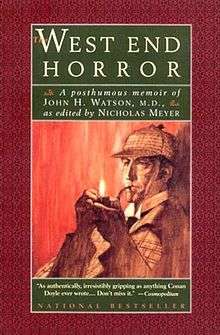The West End Horror
 First edition cover | |
| Author | Nicholas Meyer |
|---|---|
| Country | United States |
| Language | English |
| Genre | Mystery novels |
| Publisher | E. P. Dutton |
Publication date | May 1976 |
| Media type | Print (Hardback & Paperback) |
| ISBN | 0-525-23102-1 (first edition, hardback) |
| OCLC | 1945569 |
| 813/.5/4 | |
| LC Class | PZ4.M6135 We3 PS3563.E88 |
| Preceded by | The Canary Trainer |
The West End Horror: A Posthumous Memoir of John H. Watson, M.D. is a Sherlock Holmes pastiche novel by Nicholas Meyer, published in 1976. It takes place after Meyer's other two Holmes pastiches, The Seven-Per-Cent Solution and The Canary Trainer, though it was published in between the two.
The plot concerns a series of strange murders in London's theatre district at the end of the 19th century. Contrary to what the press has sometimes asserted, The West End Horror has nothing to do with (though it arguably bears subtle references to) Jack the Ripper or his crimes, which took place in and around the Whitechapel district of the East End. It also includes a first meeting between Holmes and Doctor Moore Agar, whose "dramatic introduction to Holmes" was one that Watson, in the original Arthur Conan Doyle story "The Adventure of the Devil's Foot", wrote that he "may some day recount."
The West End Horror made The New York Times Best Seller list for eleven weeks between June 13, 1976 and August 22, 1976.[1]
Plot
The book is written in the form of a false document. It opens with a foreword by Meyer, who states that the manuscript was brought to his attention by a woman with some familial connection to Horace Vernet, also an ancestor of Holmes. The woman had read The Seven-Per-Cent Solution and thought Meyer might be interested. Although damaged by water, the manuscript proved authentic.
Dr. Watson explains in his own preface that he did not publish the story because of the number of well-known persons who would be affected - persons whose identity would be impossible to disguise. Holmes had for a long time refused Watson permission to write the story on these very grounds, but Watson eventually persuaded him by promising to place the manuscript in Holmes' hands, the only condition being that he not destroy it.
The story involves many well-known people, including George Bernard Shaw, who hires Holmes to look into the death of an unpleasant theatre critic; Sir Arthur Sullivan, one of whose singers at the D'Oyly Carte Opera Company was another victim of the murderer; and others including W. S. Gilbert, Oscar Wilde, Bram Stoker, Henry Irving, Ellen Terry and Frank Harris.
In the novel, Holmes clears the name of a shy Parsee Indian wrongfully accused of murder; in real life Conan Doyle played a significant part in helping George Edalji, a Parsee victim of injustice in the English court.
References
- ↑ Adult New York Times Best Seller Lists for 1976. Retrieved 23 December 2012.